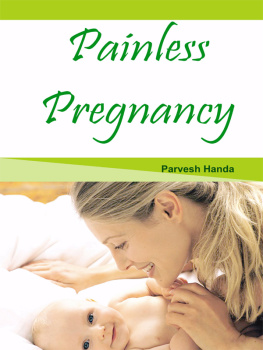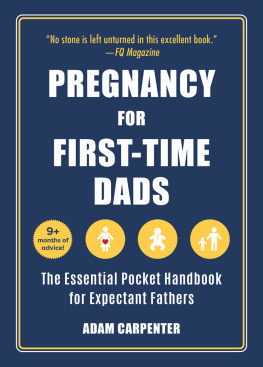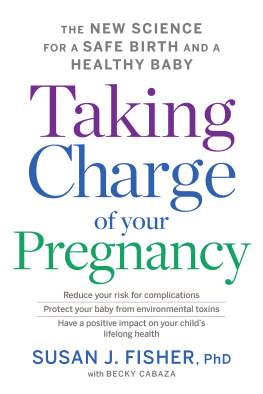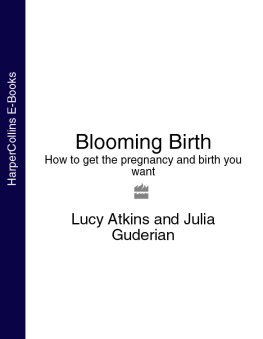This book is not intended to take the place of medical advice from a trained medical professional. Readers are advised to consult a qualified doctor or a gynecologist regarding treatment of their medical problem. Neither the author or publisher takes any responsibility for any possible consequences from any treatment, action or application of medicine,, herb or preparation to any person reading or following the information in this book.
The birth of a baby is the birth of a family and a joyous event. This book by Ms Parvesh Handa would educate all those women going to be mother first time and provide a practical guide to painless childbirth. Care has been taken to help expecting mothers and their partners to learn what they need to make good decisions, adopt techniques for a painless pregnancy and pleasant childbearing period. This book would enhance relationship between expecting mother and her companion gain the information, skill, confidence and active participants in their own care.
The psychomotor skills, such as simple exercises and practice of yoga postures, relaxation, labor positions and comfort measures are a vital part of preparation for childbirth. It is hoped, readers would find it enjoyable as they use it to prepare for a safe and joyful birth and confident family beginning. Pregnancy is a state that lasts about nine months when a unborn baby is transforming into a person capable of life outside the safe, protective and totally sufficient environment of the mothers body. The birth process follows three stages of pregnancy, followed by labour and delivery of the child thereby providig complete transition from pregnancy parenthood.
Remember, pregnancy is not a disease, although at this time of extra demand on body, one is more vulnerable to medical complications than at other times in life.
Dr D.S. Jaspal
National Vice President
Indian Medical Association
Know Your Body
Every woman on way to become a mother should know about her body thoroughly. There are several women, some of them going to be married or are expectant mothers but they have least knowledge of their own body organs. Most of the teenagers and even newly married women feel hesitant to question about male or female genitals organs, though their knowledge is essential for every one to make married life and pregnancy more enjoyable and healthy, and also allay fears and misconception.
The vulva: The vulva is an ill-defined area, which in gynecological practice comprises the whole of the external genitalia including the perineum. A womans perineum includes the pelvic floor muscles, external genitalia, urethra, anus and perineal body the area between the vagina and anus. The external genitalia include the vaginal opening, clitoris, labia majora, labia minora and mono pubis fatty tissue over the pubic bone. The mons pubis is the only part of the genital organ visible when the woman is in the upright posture, with a cushion of fat in front covered after puberty with more or less short curly hair. The mons pubis is continued in a backward direction into the two outer lips of the vulva (called labia majora). At puberty, hair appears at the outer surface of the labia majora and in some cases on the skin of the perineum as well. The inner surface of the labia majora is soft, moist, pinkish colored and hairless. The skin here contains sebaceous glands, sweat glands and hair follicles. The skin of labia majora is liable to common skin disorders such as lesions, boils and cysts. The labia minora lie on the inner aspect of the labia majora a thin fold of skin, which do not contain sebaceous glands or hair follicles but have veins and elastic tissue, which erect during sexual activity.
Bartholins gland is a compound gland measuring about 10 mm. in diameter and about 25 mm. long, which secrete lubricating mucus during coitus. The clitoris consists of a glans covered by the prepuce and a body which is subcutaneous and corresponds to the penis and is attached to the under surface of the pubis. The clitoris is extremely sensitive and during coitus it becomes erect and plays a considerable part in inducing the orgasm of the female. The vaginal orifice is surrounded by hymen. In virgins the hymen is surrounded by thin membrane covering the surface.
The Uterus: The womb is the compartment of female body in which a baby forms and grows till birth. It is also termed as uterus, a pear-shaped hollow thick walled muscular organ situated in the pelvis behind the bladder and in front of the rectum, deep in the lower abdomen. Uterus is divided into two parts an upper part called the body and the lower part called the cervix, which protrudes into the vagina, the stretchy canal connecting the internal and external genitalia. The uterus is usually of size 3x2x1 when in non-pregnant state and it stretches gradually in size to accommodate a fully formed baby. The size and shape of the normal uterus varies throughout the life. An infantile uterus ranges from 2 to 3.3 cm. in length with the cervix accounting for two third of the total length and 0.5 to 1 cm. in diameter. As the puberty approaches, the uterus gradually increases in size with more pronounced growth in the body to the eventual adult pear-shaped appearance. Congenital uterine abnormalities occur in approximately 0.5% of females and associated with increased incidence of abortion and other obstetric complications. Sonogram or an ultrasound may detect anomalies of the uterus. The fallopian tubes extend from the upper sides of the uterus towards the ovaries. Two ovaries located on each side of the uterus are a womans sex glands, which produce estrogen and progesterone the female sex hormones. During adolescence, along with hormones from the pituitary and adrenal glands, estrogen stimulates the development of secondary sexual characteristics in the female such as enlarged breasts, body hair. The ovaries also ripen and expel ova (eggs). Out of thousands of ova present in the ovaries, only 400 to 450 are ovulated in a womans lifetime.

How conception and pregnancy take place?: The question arises, how conception take place and pregnancy develops. After sexual intercourse, sperm travel from vagina through the cervix into the cavity of the uterus and along the fallopian tubes. Conception takes place when a single sperm penetrates or fertilizes an ovum, forming a single cell. At the moment a woman becomes pregnant, a new life begins. Although, large numbers of sperm ejaculate and reach the ovum, only one penetrates it. Once ovum is fertilized, a chemical reaction occurs, preventing other sperm from penetrating it. After fertilization, which takes place in the outer one-third of the fallopian tube, the ovum travels along the fallopian tube and embeds within the lining of the uterus. Each ovum and sperm contains 23 chromosomes - the full component of 46 chromosomes, which combine to give the baby unique inherited characteristics such as skin, hair and eye color, height, body shape, type of blood, sex etc. The sex of the unborn child is determined by the type of chromosomes contributed by the male partner. For example, if a sperm carrying an X chromosome fertilizes the egg, the baby is a girl (XX), whereas the sperm carrying a Y chromosome fertilizes the egg, the baby is a boy (XY).










